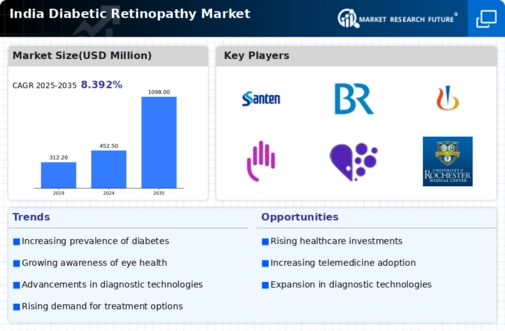The India Diabetic Retinopathy Market presents a dynamic and rapidly evolving landscape characterized by the increasing prevalence of diabetes and its associated complications. Diabetic retinopathy stands as one of the leading causes of blindness among adults in the country, driving demand for innovative treatment solutions and advancement in diagnostic technologies.
The competitive insights within this market reveal a strong focus among various players on enhancing their product offerings, investing in research and development, and forming strategic partnerships.
The emphasis on effective management of diabetic retinopathy through both pharmacological and non-pharmacological approaches has led to an intensified competitive atmosphere as companies strive to capture market share and meet the needs of healthcare providers and patients alike.
Additionally, collaborations between pharmaceutical companies, healthcare institutions, and research organizations are becoming increasingly common, aiming to accelerate innovation and improve patient outcomes in the growing Indian market.
Santen Pharmaceutical has a notable presence in the India Diabetic Retinopathy Market, emphasizing its commitment to providing high-quality ophthalmic solutions tailored to address diabetic eye disorders. The company's strategic focus on research and development has led to the introduction of specialized products that cater to the unique challenges faced by diabetic patients in India.
With a customer-centric approach, Santen Pharmaceutical has established strong relationships with healthcare professionals, fostering trust and brand loyalty. Furthermore, their dedication to incorporating the latest advancements in surgical techniques and ophthalmic care positions them as a leader in the segment.
The emphasis on education and awareness campaigns about diabetic retinopathy further strengthens their market presence, ensuring both patients and healthcare providers are informed about the importance of early detection and treatment.
Bayer also plays a pivotal role in the India Diabetic Retinopathy Market, with a robust portfolio of innovative therapies aimed at effectively managing this condition. The company's flagship products include intravitreal injections that have shown significant efficacy in treating diabetic macular edema and other diabetic retinopathy-related complications.
Bayer's extensive distribution network and strong relationships with ophthalmologists ensure that its products are readily accessible across various healthcare settings in India. Through strategic mergers and acquisitions, Bayer has enhanced its capabilities and broadened its market reach within the country.
The company is investing in educational initiatives to raise awareness about diabetic retinopathy among patients and healthcare providers alike, contributing to a more informed population that understands the importance of timely intervention.
Bayer's commitment to ongoing research and development in the field further solidifies its position as a key player in the Indian market, reflecting its strength and dedication to improving patient outcomes in diabetes-related eye health issues.



















